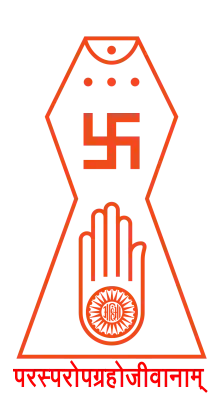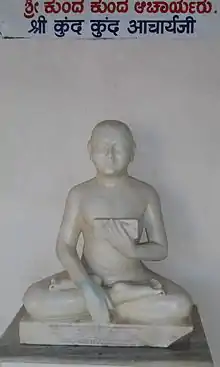Timeline of Jainism
Jainism is an ancient Indian religion belonging to the śramaṇa tradition. It prescribes ahimsa (non-violence) towards all living beings to the greatest possible extent. The three main teachings of Jainism are ahimsa, anekantavada (non-absolutism), aparigraha (non-possessiveness). Followers of Jainism take five main vows: ahimsa, satya (not lying), asteya (non stealing), brahmacharya (chastity), and aparigraha. Monks follow them completely whereas śrāvakas (householders) observe them partially. Self-discipline and asceticism are thus major focuses of Jainism.
| Part of a series on |
| Jainism |
|---|
 |
|
|
Before common era (BCE)
- 584,979–574,979 BCE: Naminatha, 21st Tirthankara[1][2]
- Neminatha, 22nd Tirthankara: According to Jain beliefs, he lived 84,650 years before the 23rd Tirthankara, Parshvanatha.[3] He existed in the Mahabharata era and was the cousin brother of Krishna.[4]
- 877–777 BCE: Parshva, 23rd Tirthankar of Jainism. He is the earliest Jain leader who can be reliably dated.[5][6][7][8]
- 599–527 BCE: Mahavira, 24th and last Tirthankar of this era.[9]
- 5th century BCE: Siddhasen Diwakar
- d. 507 BCE: Ganahar Sudharma Swami
- d. 357 BCE: Acharya Bhadrabahu
- d. 162 BCE: Hathigumpha inscription mentions the Namokar Mantra and Jain monarch Kharvela.[10][11][12]
- 2nd century BCE: Namokar Mantra epigraphically attested in Maharashtra
Common era (CE)

Sculpture depicting Acharya Kundkund
- 1st century CE: Acharya Kundkund
- 87 CE: Pushpadanta starts to write Shatkhandagam
- 156 CE: Acharya Bhutabali completes writing of Shatkhandagam
- 454 CE: Devardhigani compiles Jain Agamas
- 5th century CE: first mention of the Mula Sangh order
Middle Ages
- 9th century
- The Tirumalai complex in Tamil Nadu is established.
- 10th century
- Life of Nemichandra, a famous Jain author.
- Jain temple of Gurjiwada, Cudnem, Bicholim, Goa was constructed.[13]
- 982: Monolithic statue of Bahubali erected at Shravana belagola
- 12th century
- Kashtha Sangh
- 1172: Acharya Hemachandra
- 1194: Tristutik
- 13th century
- 1229: Tapa Gachchha
- 15th century
- 17th century
- 1664: Digambar Terapanth
- 1658: Digambara Jain Lal Mandir temple in Delhi built.
- 18th century
- 1760: Swetembar Terapanth
- 1780: Sthanakvasi and Terapanthi orders
British India
- 1868: Jain temple in Mumbai
- 1880s: reform movement of Acharya Rajendrasuri
- 1893: Virachand Gandhi participates in Chicago's World Parliament of Religions& Won Silver Medal.
- 1904: Jain temple at the Louisiana Purchase Exposition
- 1927: Madras High Court in Gateppa v. Eramma and others recognizes "Jainism as a distinct religion"
Post-Partition
- 1970s: significant presence of Jainism in the United States
- 1972: Aacharya Shri Vidyasagar Maharaj elevated to the Acharya status.
- 1975: Acharya Sushil Kumar (Jain monk) ji travels to USA. The first Jain muni to travel by air out of the Indian subcontinent.
- 1975: Monolithic statue of Bahubali is installed at Dharmasthala, Karnataka, India under the auspices of D. Rathnavarma Heggade and Mathrushree D. Rathnamma Heggade, members of Dharmasthala's Jaina lineage who also manage the local Shivaite temple. Carving work began in 1966 under the sculptor Rejala Gopalkrishna Shenoy of Karkala.
- 1976: In Arya Samaj Education Trust, Delhi & Others v. The Director of Education, Delhi Administration, Delhi & Others (AIR 1976 Delhi 207), the Court referred to Heinrich Zimmer's Philosophies of India describing Jainism as "a heterodox Indian religion" and J. N. Farquhar's Modern Religious Movements in India describing Jainism as "a rival of Hinduism."
- 1981: First Jain convention in Los Angeles
- 1983: Formal organization of JAINA (Jain Associations in North America)
- 1990: Temple Pratishtha, The Jain Sangh Cherry Hill, New Jersey
- 1990: Temple Pratishtha, Jain Society of Metropolitan Washington
- 1991: Founding of Siddhachalam, the Jain tirtha
- 1991: Death of Jain Acharya Shri Ramchandra Surishwarji
- 1993: Temple Pratishtha, Jain Society of Metropolitan Chicago
- 1995: Temple Pratishtha, Jain Center of Cincinnati and Dayton
- 1998: Temple Pratishtha, Jain Society of Greater Detroit
- 2000: Temple Pratishtha, Jain Center of Northern California (JCNC)
- 2000: Jain Vishwa Bharati Orlando
- 2005: the Supreme Court of India declined to grant Jains the status of a religious minority throughout India, leaving it to the respective states to decide on the minority status of Jainis.
- 2006: the Supreme Court opined that "Jain Religion is indisputably not a part of the Hindu religion" (Para 25, Committee of Management Kanya Junior High School Bal Vidya Mandir, Etah, U.P. v. Sachiv, U.P. Basic Shiksha Parishad, Allahabad, U.P. and Ors., Per Dalveer Bhandari J., Civil Appeal No. 9595 of 2003, decided On: 21.08.2006, Supreme Court of India.)
- 2008: Delhi city government declares Jain community a minority per the Supreme Court Orders.
- 2014: Jain community is designated a minority at the national level.[14]
See also
- History of Jainism
- Jain philosophy
- Shramana
Notes
- "NamiNatha Bhagwan". http://jainmuseum.com. External link in
|website=(help) - "About Tonks Of 24 Jain Tirthankaras On Parasnath Hills Information-Topchanchi". hoparoundindia.com.
- Zimmer 1953, p. 226.
- Jinasena, Acharya; Jain (Sahityacharya), Dr. Pannalal (2008). Harivamsapurana [Harivamsapurana]. Bhartiya Jnanpith (18, Institutional Area, Lodhi Road, New Delhi - 110003). ISBN 978-81-263-1548-2.
- Fisher, Mary Pat (1997). Living Religions: An Encyclopedia of the World's Faiths. London: I.B.Tauris. ISBN 1-86064-148-2. p. 115
- "Parshvanatha". Encyclopædia Britannica. Encyclopædia Britannica Online. 2007. Retrieved 22 October 2007.
- Bowker, John (2000). "Parsva". The Concise Oxford Dictionary of World Religions. Oxford Reference Online. Oxford University Press. Retrieved 22 October 2007.
- Deo, Shantaram Bhalchandra (1956). History of Jaina monachism from inscriptions and literature. Poona [Pune, India]: Deccan College Post-graduate and Research Institute. pp. 59–60.
- "Mahavira." Britannica Concise Encyclopedia. Encyclopædia Britannica, Inc., 2006. Answers.com 28 Nov. 2009. http://www.answers.com/topic/mahavira
- Rapson, "Catalogue of the Indian coins of the British Museum. Andhras etc...", p XVII.
- Full text of the Hathigumpha Inscription in English Archived 17 November 2006 at the Wayback Machine
- Cort 2009, p. 39-41.
- Kerkar & TNN 2014.
- Government notification- minority
References
- Kerkar, Rajendra; TNN (31 October 2014), "Jain heritage dwindles as govt sits pretty", The Times of India
- Bedrij, Orest (2013). The Greatest Achievement: Miracle after Miracle the Easy Way. Xlibris Corporation. ISBN 978-1-4931-0773-5.
- Bedrij, Orest (2011). Exodus III: Great Joy and Glory to the Most High as You. Xlibris Corporation. ISBN 9781462879915.
- Cort, John (16 November 2009). Framing the Jina: Narratives of Icons and Idols in Jain History. United States: Oxford University Press. ISBN 9780199739578.
- Shah, Natubhai (2004), Jainism: The World of Conquerors, 1, Motilal Banarsidass, ISBN 978-81-208-1938-2
- Sangave, Dr. Vilas Adinath (2001). Facets of Jainology: Selected Research Papers on Jain Society, Religion, and Culture. Mumbai: Popular Prakashan. ISBN 978-81-7154-839-2.
- Glasenapp, Helmuth Von (1999), Jainism: An Indian Religion of Salvation, Delhi: Motilal Banarsidass, ISBN 81-208-1376-6
- Zimmer, Heinrich (1953), Joseph Campbell (ed.), Philosophies Of India, London, E.C. 4: Routledge & Kegan Paul Ltd, ISBN 978-8120807396CS1 maint: location (link)
External links
This article is issued from Wikipedia. The text is licensed under Creative Commons - Attribution - Sharealike. Additional terms may apply for the media files.